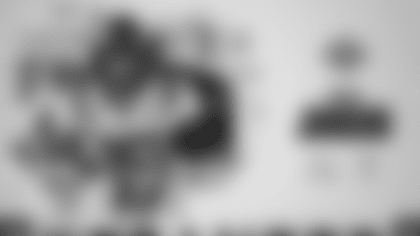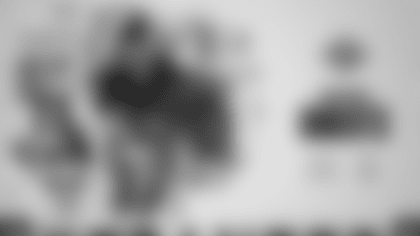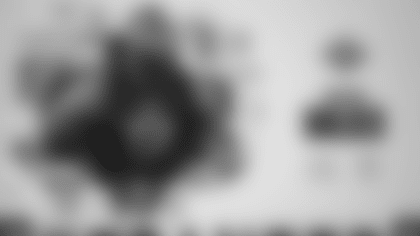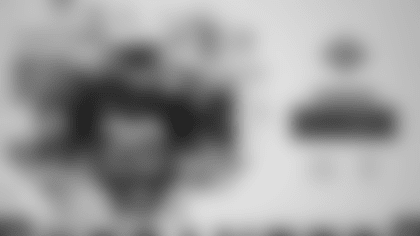TE Alex Smith caught a 22-yard pass off a flea-flicker in last Sunday's game against Carolina
(Note: The following story was featured in Volume 1, Issue 4 of Buccaneers Review, the Tampa Bay Buccaneers' ground-breaking new game program. Buccaneers Review has reinvented the game program with magazine-style presentation, in-depth and current analysis of both teams and dozens of pages of fresh content every issue.)
This is how a tight end ends up taking a handoff and throwing a wrong-handed pass into the end zone.
This is how a fullback with an otherwise career-long reception of 25 yards catches an uncontested 51-yard touchdown pass against one of the NFL's best defenses.
This is how a punter lobs a pass that is nearly intercepted by a safety before it is wrestled away by a 280-pound defensive end who then drags his toes on the sideline like a ballerina for two points.
This is even how Joey Galloway ends up saving a touchdown on special teams by making an open-field tackle on John Lynch. Yes, you read those names in the right order.
This? This is the trick play, in all its glory…and, sometimes, all its folly.
**
Admit it. You love trick plays.
In a game where most coaches punt from the opposition's 37-yard line, in a league where the decision to go for two is left up to a soulless spreadsheet kept handy on the sideline, the trick play is an unexpected rush. On a trick play, those understandable conservative tendencies are suppressed just long enough for, say, a halfback to pitch it back to the quarterback on a flea-flicker, or for the long-snapper to hike the ball directly to the kicker for a run around the end.
The NFL is exciting as it is, but the trick play brings an added jolt of adrenaline as soon as you realize something odd is happening. Wait, the receiver is lined up in a shotgun behind the center?! This should be interesting. You don't know if it's going to work, but you know something very good or something very bad is almost certainly about to take place. It's the ultimate risk-reward moment in a sport in which every game and every down is already so critical.
It is that possibility for disaster, obviously, that makes the trick play a relative rarity in the NFL. For instance, take that most sublime trick play, the flea-flicker, the one even close-to-the-vest coaches sometimes pull out when the opposition safeties are getting too aggressive in run support. The Giants used it to perfection in Super Bowl XXI, with the red-hot Phil Simms hitting Phil McConkey for a 44-yard gain down to the one. The Redskins, on the other hand, would probably like to have their flea-flicker pass in Super Bowl XVII back, given that Joe Theismann's pass was intercepted by Lyle Blackwood. Safe to say Theismann has no love for the play. Just two years later, he would suffer a gruesome and ultimately career-ending leg fracture after the Giants Lawrence Taylor was quite seriously not fooled by another flea-flicker attempt.
"If you're going to run the play, you've got to make sure it's for a certain defense," said Tampa Bay Buccaneers Head Coach Jon Gruden of those pages in the back of the playbook. "If you don't get that defense, you're not going to get the result you want, and it's potentially a scary outcome. You have a quarterback in an unsound protection and you don't have a receiver to throw the ball away to. There's a lot of risk involved with running these plays."
But they can work. On December 19, 1992, in an otherwise unsatisfying day for the Buccaneers in San Francisco, Vinny Testaverde successfully ran the flea-flicker against the 49ers, who had ranked in the top five in defense each of the previous five seasons. Testaverde handed off to Gary Anderson, who ran towards the middle of the line, stopped and pitched back to Testaverde, who threw deep over the middle. The pass found fullback Anthony McDowell, not known for his deep routes, behind every last 49er defender, and the result was an easy 51-yard touchdown and a 7-0 first-quarter Buccaneer lead. Unfortunately, San Francisco rallied for a 21-14 win on a fourth-quarter Steve Young-to-Jerry Rice touchdown.
The Bucs' head coach at the time was Sam Wyche, sometimes referred to as "Wicky-Wacky Wyche." He despised that nickname, but it's fair to say that the Bucs were a little more, um, adventurous in their play-calling during his tenure. Two preseason games into Wyche's first season, this headline ran in a local newspaper: "Wyche's trick plays work like magic." It was just a year later, in another game against the 49ers, that Dave Moore threw his one and only career pass. Trailing 31-14 in the third quarter but with the ball at San Francisco's three-yard line, Wyche sent Moore on an end-around. Repeat, the tight end on an end around. As he ran left toward the end zone, Moore tried to pull up to pass but had to use his non-throwing hand because a 49ers defender had almost completely wrapped him up. The Bucs were lucky the play was merely incomplete, allowing them to score on a conventional run up the middle by Vince Workman on the next snap.
Things were decidedly looser in the early '90s. This was the same team that actually let representatives from Outback and Hooters restaurants design and call the first two plays of the first preseason game of 1992 as a charity fundraiser. Outback's play resulted in a 26-yard completion to tight end Ron Hall but was a relatively conventional opening to the August 8 game at Denver. However, on the second play, at the behest of the Hooters mad scientists, Vinny Testaverde feigned walking away from the center and towards the coach on the sideline, as if he was confused and was going to call a timeout. The rest of the offense stayed set and the center eventually snapped the ball directly to Anderson. The Broncos did relax a bit and Anderson got 12 yards, but alas, the play was called back on a holding call against Hall.
Such hi jinx might have no chance of happening in the current Buccaneer era, but the decrease in the number of conventional trick-play moments – is that an oxymoron? – is more about the increase in defensive trickery than any shift in organizational philosophy.
"It's not as common anymore that you find a defense that lines up in a predictable front or coverage," said Gruden. "There are so many different looks, it's almost hard to try to call a play in which you're specifically trying to fool someone. You don't know if they're going to be a nickel defense or base defense or whatever. You just don't see as many of those trick plays as you used to, probably for that reason."
Cornerback Ronde Barber, in fact, had a hard time thinking of the last one an opponent tried on the Bucs…except for the halfback pass, which Barber dismissively waved off as being unworthy of the genre. (Not to say it doesn't work. The Bucs famously didn't notice that the Jets' Curtis Martin had taken the glove off his right hand before a play late in a September 24, 2000 game at Raymond James Stadium. Martin threw the game-winning touchdown pass to Wayne Chrebet on a well-executed halfback pass on that very snap.) Barber agrees with Gruden on the issue of getting the right defense for the right call, and adds that sometimes you might think you've got it when you really don't. Now that is a disaster waiting to happen.
"A lot of defenses disguise so much you don't really know what you're getting," said Barber. "You don't really know if you've got the right look for what you want.
"Most teams won't do it much. There are certain offensive coordinators – and Monte [Kiffin] knows who they are – who always have at least one or two tricks per game. Whether it's putting the receiver in the backfield to get a snap or something like that. But, like I said, we know that going into a game."
Most teams, on the other hand, are prepared with a handful of fake punts and placekicks on any given Sunday. Most of those Sundays will pass without the fake being called, largely because coaches want the perfect scenario before they'll do something that risky. A failed double reverse might lose you eight or 10 yards; a failed fake punt can hand a scoring opportunity to the opponent.
"Every team practices a handful of trick plays on special teams, different things to attack different looks," said Buccaneers punter Josh Bidwell. "They're always in the book, even if we don't talk about it that week, but for some reason we have to run it guys know what to do and we're ready to go.
Bidwell has thrown the ball on fakes twice while in college and once in the NFL preseason – just this year, in fact. Holding for the extra point after the game-opening score at Jacksonville on August 26, Bidwell took the snap and rolled right, eventually throwing under pressure into a crowded corner of the end zone. Jags safety Donovin Darius appeared to catch the ball to thwart the try, but he bobbled it just long enough for defensive end Dewayne White, the intended target, to swipe it away and then pull his receiver-like balancing act on the sideline.
Bidwell admits that he wouldn't mind a chance to pass on a punt or placekick in the regular season, when it really counted, as long as the situation was perfect.
"It would be fun," he said. "I would like an opportunity at some point if it was a gimme play. We've had a couple set up. We've had some calls throughout the seasons, even here, where we had a trick play, a fake punt or field goal in for a game but the situation never came up. Or, we were right where we needed to be and we gave up a sack or gave up a turnover and weren't able to call it. The finger's been on the trigger a couple times but fate has kept us from running it."
The Bucs did pull the trigger once in 1996, in Tony Dungy's fourth game at the helm. Leading 10-3 over the visiting Seattle Seahawks on September 22, the Bucs kept an eventual 80-yard touchdown drive alive with a bit of fourth-down trickery.
At the time, Lynch played the position of "upback" or "fullback" on the punting squad, the player who stands between the center and the punter and calls for the snap. On this play, the center snapped the ball directly to Lynch, who simply ran forward through a gap in the middle of the line and broke into the clear. He might have gone the distance if not for the fine open-field work of the Seahawks' punt return man.
Class, can anyone name Seattle's primary punt returner in 1996? Yep, Joey Galloway. The speed demon showed his grit on this one, refusing to let Lynch get around him to the end zone. The thing is, 10 years later Galloway couldn't tell you who it was that had the ball in his hands on that play. "I've been involved in that situation three times, where I was the last guy who could tackle the guy running the fake. I couldn't tell you who any of those guys were."
But did he make the tackle all three times? You betcha.
Most players remember every detail of their favorite trick plays, but of course Galloway's team was on the receiving ends of those goofy moments. Buccaneers quarterback Chris Simms vividly remembers his father's flea-flicker, for instance. He also fondly recalls a moment in the seventh grade when, playing for a powerhouse team, he intercepted a deep pass and ran it back about 50 yards before, just at the moment of impact, pitching it to the team's fastest player, who went the rest of the way. That's more of an impromptu bit of deception than a true trick play, but it's burned indelibly in Simms memory. "It might be the coolest thing I've ever been associated with," he said.
Or ask running back Michael Pittman to recall his favorite trick-play moment and he perks up immediately, rattling off the details of a wild play from 1999 as if he was reading them from a play-by-play. It was a halfback pass Pittman threw while still playing for the Arizona Cardinals.
"The players involved were me, Jake Plummer and Frank Sanders," said Pittman, a big smile crossing his face. "It was a toss right and Frank Sanders ran a post-corner route. Jake tossed it to me on the right-hand side and I threw a 30-yard pass.
"We probably practiced that one about four or five times before that game. We knew it would work just because of the way the Miami defense runs to the ball. What it is, Frank Sanders pretends like he's going to block, he sells a crackdown block, but then he took the post hard. The way we ran it, the Miami defense all sucked up and Frank was wide open. I hit him at the five-yard line. It was a good pass, a spiral."
Okay, maybe Pittman doesn't have every detail perfectly committed to memory. It was actually a 26-yard pass. But it was complete, for sure, and Pittman can take solace in his career 118.8 passer rating, if not a victory in that game. Miami won, 19-16.
Mike Alstott is not so lucky. He got the same call as Pittman, essentially, but no completion for his career stat chart. In a 1998 game against Green Bay, Alstott took a toss and waited until the last moment to fire up his first career pass. It looked good in the air, but…
"It was just a toss right," said Alstott. "I sold the run and Reidel Anthony did a fly-stop, came back to the ball. I waited until the last second before I got to the sideline, threw it right to him, hit him in the chest, and he dropped it."
Alstott has a good arm, as anyone who has seen him play the "Crossbar Game" during pregame warm-ups can attest. He's had two tries on the halfback toss, however, and is 0-2, giving him a career passer rating of 39.6 and suggesting that even when a trick play works, it doesn't necessarily work.
That's yet another check mark in the risk column of the risk-reward analysis, and another reason why you'll have to resign yourself to only catching an NFL trick play every now and then, as fun as they are. Don't rule the trick play out, Buc fans, but don't expect it to return in full force any time soon.
"We've been known to run an occasional flea-flicker, we've seen an occasional double-reverse," said Gruden, who in fact did run a successful flea-flicker against Carolina on Sunday. "Everybody engages in a certain amount of trickery, but that's more for backyard ball these days."






















